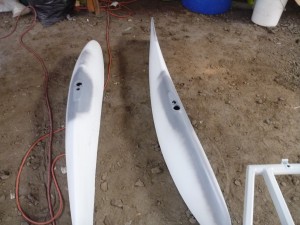As a point of reference, my Maule, which is similar in size and construction to the Bearhawk, has the static ports in the back behind the aft bulkhead, as Battson and Jared have done with theirs.
Announcement
Collapse
No announcement yet.
Static port locations
Collapse
X
-
When I bought my completed BH it was equipped with a long mast type pitot tube that had the static ports built in just aft of the front pitot hole. I found that the airspeed indications over read in the low speed regime and under read in the high speed regime. I ended up disconnecting the static portion of the plumbing and left it inside the wing root so my static pressure is actually taken inside the wing and it works like a charm. I bought the supplies (ports & tubing) to put proper static ports on the aft fuselage but every time i think of doing it I remind myself that I'm fixing something that aint broke so in the wing root it will stay for the time being.Bearhawk 4 Place
IO-540
MGL Odyssey Gen 2 EFIS
ABW 29" Tires
Appareo ESG ADSB-Out
Garmin GTR-200 COMM
Comment
-
I'm going to rivet a couple of plates to the stringers to mount the static ports behind the baggage bulkhead. The ADAHRS are also going high behind the bulkhead so the static runs should be short and go straight up to the ADAHRS. I don't have to take static forward as I am going to use a Dynon D2 as my backup and that uses GPS data.
Comment
-
I'm working through how I'm going to do my pitot/static system. Here is my current plan based on what other have done, cost, weight, and reliability:
Have two static ports aft of the rear bulkhead. On the inside of the fuse I'll have a sheet aluminum backing plate attached to the stringer, on the outside of the fuse I'll glue a simple static port I machine out of aluminum on my lathe. They will look like this: http://www.aircraftspruce.com/cache/...s/10-00250.jpg and will be glued or riveted on. The back side won't have a barb, instead a smooth 1/4" shank.
On the shank I'll put these push on elbows (https://www.steinair.com/product/uni...-90-degree-14/) then over to some 1/4 nylon tube to a T fitting (https://www.steinair.com/product/fitting-t-14/), then up to the back of my EFIS which attaches with with a NPT fitting (https://www.steinair.com/product/fit...raight-18-npt/)
On the pitot side I have an AN4 flare fitting so I'll use an AN818/AN819 nut/sleeve to go to a 1/4 aluminum tube, which will go to a bulkhead fitting (https://www.steinair.com/product/bul...n-straight-14/) to make sure the aluminum part doesn't move at all, then more 1/4 nylon tube to another NPT fitting.
Price is about $25.
I think this will be pretty reliable and easy to install.
- Likes 1
Comment
-
I used AN fittings at the pitot but had a bad flare and it cracked. This wasn't obvious until I was at the avionics shop a short flight away from home. Their solution was to use a length of rubber hose that fit over the unflared pitot aluminum and also over the 1/4 air brake line. This ended up being much lighter, cheaper, and faster than flared fittings.
Comment
-
Just make sure that your static lines run "upwards" immediately after the connection to the external static port, so that water (think "driving rain") doesn't get into the static system and make your instruments act crazy. After a 6" or so "upward loop" you can route them pretty much however you like to get to the ADAHRS or panel.Jim Parker
Farmersville, TX (NE of Dallas)
RANS S-6ES (E-LSA) with Rotax 912ULS (100 HP)
- Likes 1
Comment
-
This is the same as what I did too. It has been reliable.Originally posted by jaredyates View PostTheir solution was to use a length of rubber hose that fit over the unflared pitot aluminum and also over the 1/4 air brake line. This ended up being much lighter, cheaper, and faster than flared fittings.
Comment
-
schu You might also want to make the machined part modular in case you need to do some R&D regarding its shape. Apparently the airflow around it matters a little. Perhaps yours can be inspired by one that is thought to work well. And the whole idea sounds like a great Beartracks article!
Comment
-
Mine are at the next station aft of the baggage bulkhead, at the lower side stringer (just above, on the flat panel of fabric between the two side stringers). Ideally they need to clamp down over the top of the fabric, trapping it between the static port and its mounting bracket. This will avoid the fabric eventually breaking free after hundreds of hours of drumming. A glue joint will not last forever in this circumstance.
- Likes 1
Comment



Comment